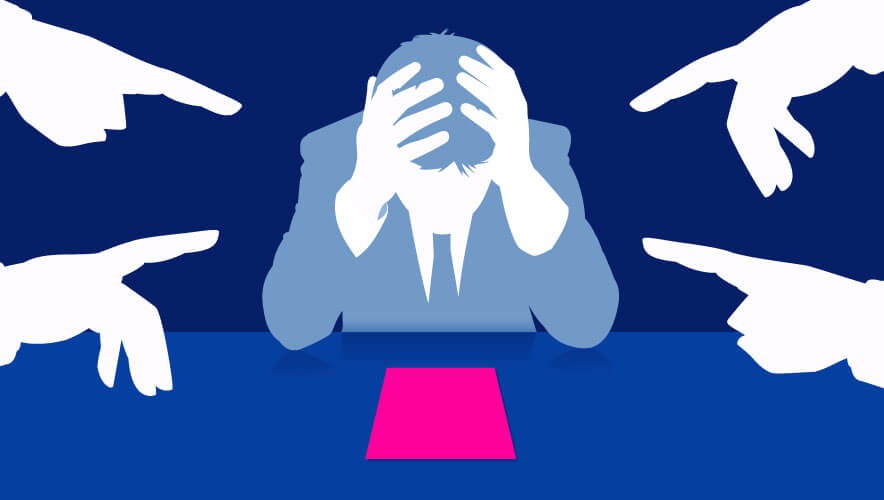Is Your Workplace Toxic? Here's What You Need to Do
The security industry has an attrition problem. With turnover rates that can soar to 300 percent among guard forces, the industry has severe challenge impacting operational and financial health. Drivers for security turnover include low compensation, lack of training, high risk activities, and poor work environment.
Considering that half the world boasts more security officers than public law enforcement, many people are surprised to learn that security officers often earn less than two-thirds of the mean national annual salary. Low compensation is often cited by senior leaders as the key reason for turnover, but it does not tell the whole story. In recent years, work environment has emerged as a significant determinant in employees' decisions to stay or leave.
Across many industries, toxic workplace culture has been a leading cause for attrition. According to research published by MIT Sloan Management in 2022, toxic workplace culture was more than 10 times more likely to drive attrition than compensation. Furthermore, women are up to 41 percent more likely than men to experience toxicity at work.
Identifying the Five Traits of a Toxic Workplace
Defining a workplace as toxic can be challenging. Researchers describe a "toxic work culture" as an environment that negatively disrupts one's personal life due to the job, the people, or the culture. We spend most of our lives engaged in work, and a toxic workplace culture can have a massive effect on our personal well-being. Truly toxic cultures impact mental health, increase burnout, and cause declines in employee well-being. Researchers identified the following five most prominent attributes of toxic workplaces:
- Disrespectful: A lack of consideration, courtesy, and respect for others.
- Noninclusive: Ignoring diverse groups of employees and excluding them from decision-making.
- Unethical: Dishonesty, regulatory violations, and false promises.
- Cutthroat: Undermining and sabotage among employees.
- Abusive: Sustained hostile behavior towards employees, including bullying and verbal abuse towards subordinates.
While some isolated experiences may indicate a negative dynamic, it's important to assess whether a workplace is toxic or merely a poor fit for your needs.
Diagnosing Toxic Workplace Culture
Organizational culture can be disappointing and frustrating for lots of reasons, including ineffective leadership, overloaded bureaucracy, or inadequate staffing. These reasons create friction, but they don't necessarily lead to toxicity. Assessing whether a workplace culture is toxic requires evaluating the organizational culture, including values, norms, and behaviors.
Culture is made up of systems that give rise to the conditions for how organizations and teams work together. Systems, protocols, and policies are all created by humans and can lead to intended and unintended outcomes. Toxic cultures may emerge from poorly designed systems or misaligned incentives that perpetuate harmful practices and behaviors. Organizations might also have distinctions between managerial and employee cultures, which affect behavior in different ways. For example, unreasonable performance metrics tied to managerial compensation can create undue stress, leading to toxic management practices.
In a 2024 Wall Street Journal article, psychiatrist Dr. Samantha Boardman cautions people to be careful about overgeneralizing other individuals as "toxic" or "not toxic." Such a reductionist binary squeezes out our capacity for empathy, understanding, and curiosity. Casually using the word "toxic" to describe someone also personalizes the problem to a single individual, rather than considering how a larger, reinforcing system may give rise to harmful behaviors. While labeling someone as toxic points a spotlight on troubling behavior, it also suggests that the person is irredeemable, with no hope for learning or growth. As Boardman writes, "We risk losing sight of their humanity."
The Effect of Toxic Workplaces
Toxic work culture hinders employee satisfaction, engagement, and commitment, and it puts people in a chronic state of psychological distress. Even if we try to rationalize the situation, abusive behavior triggers an automatic stress response in our brains and pushes us into survival mode. Activation of the sympathetic nervous system gives rise to reactions such as fight, flight, freeze, or fawn. Survival behaviors like these are embedded in humans’ evolutionary wiring, giving us a bias for survival. But over time, this automatic response becomes chronic, diminishing cognitive function and eventually wearing down the body's physiological systems and immune function. This wear and tear may eventually give rise to chronic disease and poor mental health.
Long-term exposure to toxic environments also has profound psychological effects, such as anxiety, depression, and even symptoms of post-traumatic stress disorder (PTSD). Relationships outside of work can also suffer, as work stress carries over into our personal lives. It's unfortunately common for people to stay too long in harmful, toxic circumstances because they believe there are few alternative options available to them or they fear a major change. But staying too long in such an environment can be detrimental.
It is important to refrain from blaming a victim of toxic culture. Such workplaces exact a heavy toll on self-worth and morale. That said, it is critical for people to realize that they do have the agency and power to make a change. Every day, we choose where we will work. While it can feel daunting at times, every employee has the choice to walk away from an employer and choose a different one. Doing so often requires a plan and a timeline, and the first step is identifying whether your experience warrants departure.
Step One: Diagnose the Culture
All people deserve to be treated with respect, dignity, kindness, and empathy by the people for whom and with whom we work. There are no exceptions to this adage. It is becoming more commonplace to think of the employee as a "customer" for an employer, and it is up to organizations to figure out how to retain talented, loyal, and competent staff. No matter how many stories we tell ourselves, no one must stay in a work culture that is abusive and disrespectful. Use these six steps to evaluate whether your workplace experience is toxic.
Evaluate your experience. Compare your workplace to the five toxic traits outlined above. Is your workplace experience one of toxicity or mere annoyance? If systems and processes cause irritation, can they be changed? While toxicity causes harm, more common workplace friction provides opportunities to make things better and to participate in systemic improvements.
Assess harm. Reflect on whether work interactions erode your self-worth. If toxic behavior is prevalent, consider making a change. The more your everyday work experience is influenced by toxicity, the more urgent your need to remove yourself from the environment.
Seek support. Share your experiences with a trusted confidant outside of the organization. If possible, seek out a friend or family member who is a psychologist or social worker who can offer perspective and guidance. You might also consider seeking out a career coach who can act as a knowledgeable sounding board.
Identify self-talk. Notice if you are justifying remaining in a harmful situation and challenge these narratives. Cultural mythologies are rife with stories that we unconsciously adopt. For example, in toxic workplace dynamics, some people resort to the mythology that "The devil you know is better than the devil you don't." While this may seem a harmless idiom, it can keep people in situations that they would be much better off leaving.
Uncover biases against action. Identify negative feelings related to concepts like disloyalty, quitting, or prioritizing your own well-being. Quitting a job can inspire feelings of shame or fears of failure, but researchers like Annie Duke (author of Quit: The Power of Knowing When to Walk Away) have done marvelous research on why quitting can be the best action to take. As a psychologist and professional poker player, she should know. Spoiler alert: pro quitters quit fast.
Several years ago, I spoke to a woman named Lynne worked for a verbally abusive and controlling boss for many years. When the boss was finally removed from his position, I asked Lynne what she would tell her younger self if she could. She asserted, "Just leave." Lynne was struck by how many stories she had told herself that had kept her in a bad spot all those years. The simple change of supervisor opened her eyes to the fact that she'd been needlessly tolerating harmful behavior for much of her career. "I thought that I had to prove to myself that I am strong, that I can take it," she said. "But I realize now that I was simply making a choice to be put in harm's way."
Step Two: Create a Plan for Change
If you've concluded that you work in a toxic environment, your next step is to plan to change roles or leave the organization. Departing for a new role can take some time, so it's important to create a plan that considers your personal circumstances. Keep in mind that individual employees are often unable to create significant change in organizational culture unless they themselves are in a position of executive leadership. While leaving a toxic workplace is often the best long-term solution, there are strategies individuals can use to manage toxic situations in the short-term.
Set boundaries. If possible, clearly define your limits regarding acceptable behavior and communicate them assertively. While this may not change poor behavior, it can help protect your well-being. Setting boundaries enables you to continue to work effectively with others. By setting up parameters for what behaviors or conditions you will and will not tolerate, you are protecting yourself first. The absence of boundaries can leave you feeling drained, disrespected, and frustrated. For example, if you have a manager who routinely shouts at you, you can calmly and assertively respond by saying, “I do not accept being spoken to in that way. When you are ready to discuss the matter calmly, I will be open to hearing your point of view.”
Seek support. Find allies within the organization who share your concerns and experiences. Support one another and find ways to collectively address toxic behaviors if you can. Take care not to allow discussions to devolve into victimhood and helplessness. Instead, engage in productive action by sharing your concerns with peers to compare notes and emotionally support one another; respectfully seeking guidance from leaders in the organization; and collectively sharing your experiences with human resources or organizational ethics staff. Reinforce for one another the power that you all share to make a change.
Document incidents. Regardless of whether you intend to make a formal complaint to human resources, it's important to document your experience. Keep a record of toxic interactions, including dates, times, and details. This documentation is incredibly useful should you need to escalate the situation to human resources. Keep in mind that the primary purpose of the HR function is to protect the organization, and understand that filing a complaint may not result in the actions that you desire. If legal action is required at some stage, you will need to have as much tangible evidence as possible.
Practice self-care. Prioritize your health and well-being by engaging in activities that help you manage stress, such as exercise, meditation, or therapy. While self-care is not a sufficient long-term strategy for dealing with a toxic workplace, it can help you cope in the short term as you plan your exit.
Take control of your career path. Recognize your power to take control of your career path and seek healthier environments. Start letting your network know that you are looking for a new role. Ask for new introductions from those you know, and don't hesitate to reach out to people whose work or leadership you find compelling. Follow your curiosity. Consider what you value most in a workplace, such as work–life balance, opportunities for growth, or a supportive team. Reflecting on your priorities and goals can help guide your job search and help you find a better fit.
Toxic workplace culture is harmful to both individuals and organizational outcomes. Navigating such an environment is challenging, and recognizing the signs of toxicity and taking proactive steps toward change will lead to a healthier, more fulfilling career path.
By empowering yourself with knowledge and support, you can take control of your career journey and make choices that prioritize your well-being and professional growth. Remember that you always have agency to make choices about where you work. In the meantime, double down on self-care, evaluate your priorities and goals for your career, and consider a next move that will lead to a more positive, new work experience.
Sarah Powell is an applied anthropologist, change practitioner, and human-centered designer with nearly 20 years of experience in risk and resilience. As the founder of SP2 Strategies, she helps organizations cultivate resilient leaders, teams, and organizational cultures on a large scale.













